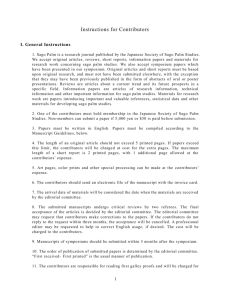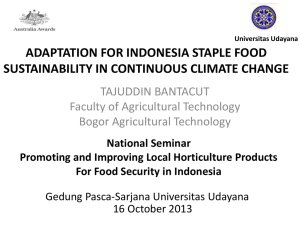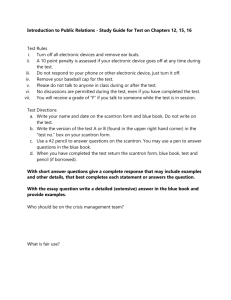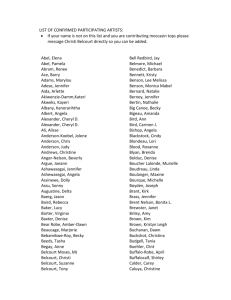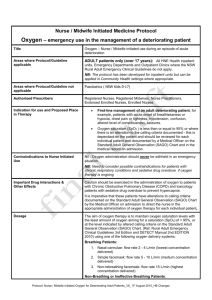The Sago Terminology among the Melanau of Sarawak (Malaysia)
advertisement
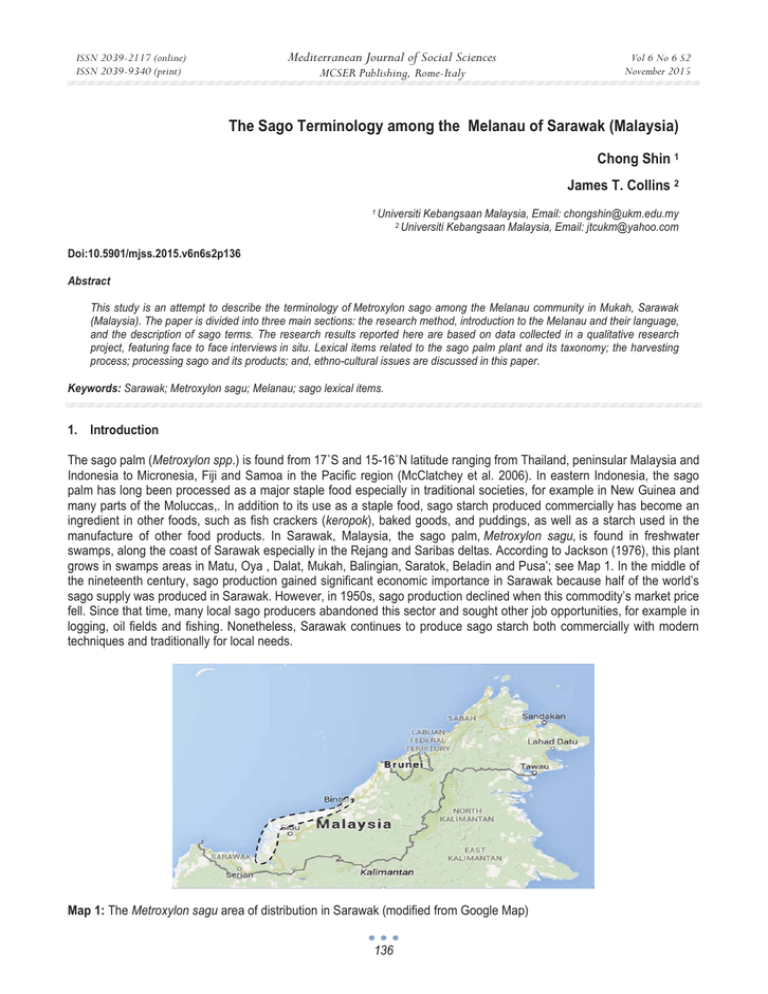
Mediterranean Journal of Social Sciences ISSN 2039-2117 (online) ISSN 2039-9340 (print) MCSER Publishing, Rome-Italy Vol 6 No 6 S2 November 2015 The Sago Terminology among the Melanau of Sarawak (Malaysia) Chong Shin 1 James T. Collins 2 1 Universiti Kebangsaan Malaysia, Email: chongshin@ukm.edu.my 2 Universiti Kebangsaan Malaysia, Email: jtcukm@yahoo.com Doi:10.5901/mjss.2015.v6n6s2p136 Abstract This study is an attempt to describe the terminology of Metroxylon sago among the Melanau community in Mukah, Sarawak (Malaysia). The paper is divided into three main sections: the research method, introduction to the Melanau and their language, and the description of sago terms. The research results reported here are based on data collected in a qualitative research project, featuring face to face interviews in situ. Lexical items related to the sago palm plant and its taxonomy; the harvesting process; processing sago and its products; and, ethno-cultural issues are discussed in this paper. Keywords: Sarawak; Metroxylon sagu; Melanau; sago lexical items. 1. Introduction The sago palm (Metroxylon spp.) is found from 17ÛS and 15-16ÛN latitude ranging from Thailand, peninsular Malaysia and Indonesia to Micronesia, Fiji and Samoa in the Pacific region (McClatchey et al. 2006). In eastern Indonesia, the sago palm has long been processed as a major staple food especially in traditional societies, for example in New Guinea and many parts of the Moluccas,. In addition to its use as a staple food, sago starch produced commercially has become an ingredient in other foods, such as fish crackers (keropok), baked goods, and puddings, as well as a starch used in the manufacture of other food products. In Sarawak, Malaysia, the sago palm, Metroxylon sagu, is found in freshwater swamps, along the coast of Sarawak especially in the Rejang and Saribas deltas. According to Jackson (1976), this plant grows in swamps areas in Matu, Oya , Dalat, Mukah, Balingian, Saratok, Beladin and Pusa’; see Map 1. In the middle of the nineteenth century, sago production gained significant economic importance in Sarawak because half of the world’s sago supply was produced in Sarawak. However, in 1950s, sago production declined when this commodity’s market price fell. Since that time, many local sago producers abandoned this sector and sought other job opportunities, for example in logging, oil fields and fishing. Nonetheless, Sarawak continues to produce sago starch both commercially with modern techniques and traditionally for local needs. Map 1: The Metroxylon sagu area of distribution in Sarawak (modified from Google Map) 136 ISSN 2039-2117 (online) ISSN 2039-9340 (print) Mediterranean Journal of Social Sciences MCSER Publishing, Rome-Italy Vol 6 No 6 S2 November 2015 2. Research Method This research results reported here were based on data collected in a qualitative research project, featuring face to face interviews in situ After identifying research sites (villages engaged in sago production) and selecting subjects for the interviews, the researcher undertook informal structured interviews by asking the subjects questions concerning sago, for example stages in sago growth, the names of tools used to produce sago starch, foods using sago starch, and the ethnographic setting of this economy. In this research, two Melanau villages in Mukah, Sarawak, were visited, namely Kampung Tabo and Kampung Telian Tengah. Although there is a modern sago factory located near these two villages, the researcher focused only on traditional modes of sago production and processing (small scale apparatuses operated by villagers). Interviews were conducted with villagers who owned and operated traditional sago processing units (Rumah Belanga or sapan) and those villagers deemed by others to have special knowledge about sago. We wish to express our thanks to Naime bt Lee, Ernie bt Sunchong from Kampung Tubo and Tommy Black from Kampung Telian Tengah for all their assistance during this study. During the informal interviews, the subjects were asked to discuss and explain sago lore and beliefs as well as the sago production process in Malay and to pronounce the lexical items in their indigenous dialect of Melanau, in this case, the Mukah Melanau variety; see Chou (2002). The information and data collected and recorded in this manner were later transcribed using the International Phonetic Alphabet (IPA). The data then were analysed and classified by using the qualitative method. 3. The Melanau The research reported here was focused on two Melanau communities in Sarawak's Mukah area. Before proceeding, some information concerning this group is set forth here. Topics touched upon include: population, distribution, language and economy. To some extend these four topics can provide an overview of the linkages between sago and sago terminology with the Melanau community, with respect to both linguistic and cultural aspects. Indeed, according to the respondents (the subjects interviewed), the entire life of the Melanau group, from birth to death, is closed tied to sago. This ethnic group, numbering 119,897 (Population and Housing Census of Malaysia, 2010) is largely found in the low-lying swampy plain of the coastal district of Sarawak, stretching from Rejang delta eastward to Bintulu, while a much smaller number reside in the upriver area of the Rejang basin near Kanowit; see Map 2. Specifically, the traditional Melanau areas in Sarawak are: Rejang, Paloh, Belawai, Daro, Matu, Igan, Oya, Mukah, Bintulu, Dalat, Medong, Kut, Narub, Balingian, Kanowit and Tatau (Yasir, 1987). Since they have always been the most prominent inhabitants of the southwest coastal district, in order to control the revenue from the sago trade, as early as four hundred years ago the Sultan of Brunei appointed Melanau representatives at the mouths of the most important sago-producing rivers, especially the Oya and Mukah rivers (Morris, 1978). Although the Melanau community has played a role in the history of Sarawak for centuries, there has been limited research conducted among them. Some claim that the Melanau comprise an ethnic group isolated from nearby ethnic groups, such as the Malay and Iban groups. However, according to Morris (1953 in Yasir, 1987), “it seems in the highest degree unlikely that the Melanau people can be distinguished in anyway on the basis of their physical characteristics…although it is legitimate to speak of a specifically Melanau culture and Melanau social organization, it is doubtful as to the extent to which the Melanau can thereby be differentiated from other neighbouring population groups”. Similarly, more recent authors have expressed difficulties in determining the relationships that obtain among the Melanau group and other ethnic groups in Sarawak; for example, MacDonald (1985) even suggested that the Melanau people are related to the Kayans. However, Clare (1972, in Morris, 1978) clearly stated that the Melanau have cultural, linguistic and social links with the Kajang people in Rejang and Baluy river areas. Blust (1974) provided a linguistic argument that the “Melanau dialect chain” is closely related to ("coordinate" with) the Kejaman, Lahana, Sekapan (that is the Kajang group) languages, spoken in the mid-reaches of the Rejang River. Indeed, using comparative linguistics with data collected during her fieldwork in the area, Chou (2002) was able to propose a contemporary, internal sub-grouping of the Melanau variants and closely related languages according to their shared phonological innovations. Her findings, restated and supported by Rensch (2012), indicate that there are five dialects of Melanau and another closely related language group, as sketched below according to Chou (2002): A Medong B Sungai Ud C Dalat Igan 137 ISSN 2039-2117 (online) ISSN 2039-9340 (print) Mediterranean Journal of Social Sciences MCSER Publishing, Rome-Italy Vol 6 No 6 S2 November 2015 D (1) Balingian (2) Mukah Oya E Matu Rejang ______________________________ F Kanowit Tanjong The communities o0000000000f Melanau speakers using varieties labeled (A) through (E) are located in the delta and coastal areas near or in the mouth of the Rejang River. The Kanowit and Tanjong speakers (F), meanwhile, reside somewhat upriver in the Rejang river valley about 200 km from the coastal region. These two groups participate in two different economic systems. On the one hand, the Kanowit and Tanjong group in the interior grow rice by swidden cultivation, whereas the coastal Melanau communities produce starch from the sago palm for subsistence as well as export. Both the interior and coastal/delta groups also engage in hunting, fishing, collecting forest products and other forms of livelihood. In fact, because the Melanau population is quite large in the coastal region, for centuries, the term (ethnonym) “Melanau” has been identical with “sago”. Map 2. The Melanau Language Areas in Sarawak (Rensch, 2012) Although there is a marked linguistic unity among the Melanau groups, as noted by Rensch (2012), the Melanau reflect a diversity in religious affiliation. As early as 1845 on his visit to Sarikei in the Rejang delta area (the southwest corner of Map 2 here), Low (1848) observed that some of the Melanau had converted from their traditional belief systems to Islam. Indeed, perhaps partially because of their distribution in the accessible coastal areas, today most Melanau speakers have embraced Islam. However some are Catholics, others Protestants, while many still follow their traditional religious beliefs. Nowadays rice has replaced sago starch as the staple food of most of the Melanau. Improvements in education and transportation have drawn many Melanau into salaried jobs. Rice and other foods can be obtained easily in this expanding cash economy. Moreover, the introduction of simple and cheap machinery by local factory owners for processing sago had changed the traditional economy of the Melanau. Their role in sago processing has been reduced to that of harvesting the sago palms and selling the semi-processed trunks to local merchants. According to Morris (1978), many Melanau were forced to sell their land and migrate as landless peasants, or to seek temporary employment elsewhere in Sarawak. One of the side effects of this phenomenon is the gradual decline of local knowledge related to the 138 ISSN 2039-2117 (online) ISSN 2039-9340 (print) Mediterranean Journal of Social Sciences MCSER Publishing, Rome-Italy Vol 6 No 6 S2 November 2015 sago palm, as well as processing and preparing it, especially among the young generation. In the next section, data collected from Melanau villagers still knowledgeable about this cultural sphere will be elaborated in order to document sago terminology in Melanau language. 4. Sago Terminology Among The Melanau Some of the lexical items related to the sago palm, harvesting, and processing it as well as ethnolinguistic terms related to sago are discussed briefly in this section. This introductory description of Melanau folk knowledge is divided into four related sections. 4.1 The plant and its taxonomy [balaw]. the sagu palm tree, Metroxylon sagu, commonly found around Mukah, Oya, Dalat, along the southwestern coast of Sarawak; see Map 1. This sago palm species reaches maturity in less than 6 years. It will grow to a height of 12-18 m in 6-14 years; see Illustration 1. The mean minimum and maximum temperatures for this plant are 17Û C and 30ÛC, respectively. It can grow on a wide variety of soil ranging from well drained soil or even poor quality soil such as sand or clay (MacClathey et al., 2006). The term [balaw] appears to be a local lexical innovation. In Proto Malayo-Polynesian (PMP) for sago palm, as reconstructed by Blust, is *Rumbia (see Tryon, 1994). In general, most of the subgroups of Malayo-Polynesian share this cognate set, for example: Lumbiya (Cebuano), rumbia (Malay), umbizo (Kadazan), tumba (Gorontalo), and humbia (Sangir); see Dutton (1994). Note the cognate is also found in the eastern branch of Malayo-Polynesian, for example lapia (Asilulu in eastern Indonesia); see Collins (2007). However, in Melanau (a subgroup of PMP) the term for sago palm has been replaced as balaw. According to Blust (2015), balaw is reconstructed in Proto Western Malayo-Polynesian as a kind of tree yielding timber (see also Zorc, 1994.) Wilkinson's (1932) definition of balau in Malay includes a verbal form membalau 'to pare off... to husk off’, perhaps suggesting the process of producing sago pith into a starch or ‘flour’. So perhaps the Melanau term suggests a semantic shift of the term for the production process to describe the entire sago palm. Of course, further study, both in semantic reconstruction and ethnolinguistic aspects, such as taboo language, should be carried out. Illustration 1: The [balaw] tree, Metroxylon sagu [uƾun]. The bark of the sago palm. The bark, to which adhere leaf sheaths, is gray and rough. This bark is removed to obtain the fibrous pith needed to produce sago starch. [tajuԥ]ݦ. The edible bud of the sago palm, palm cabbage, located in the center of the crown of pinnate leaves. After the sago palm is chopped down, the trunk is separated from the pinnate leaves (crown) with a long machete [paܵeaƾ tԥbuԥƾ], nowadays more often a chainsaw. After the palm trunk is taken away for processing, the crown is split 139 ISSN 2039-2117 (online) ISSN 2039-9340 (print) Mediterranean Journal of Social Sciences MCSER Publishing, Rome-Italy Vol 6 No 6 S2 November 2015 and the sago palm cabbage is removed for cooking. [lawey]. The stump of a felled sago palm. The scarab or beetle, Euchirus longimanus, often chooses the stump to lay its eggs. The grubs bore great holes in the soft fiber of the stump which is their chief source of nutrition. Below the nutritional value of the grubs themselves is discussed. 4.2 The Harvesting Process [susa:h]. Prepare the trunk of the sago palm for harvesting by scraping off dry leaves and old stems from the trunk before the palm tree is chopped down. [tubԥƾ]. Cut down a sago palm for harvesting. Palms are usually harvested at the age of 7 years before the efflorescence of the palm. Today a chain saw is typically used to cut down a palm. [mukap]. Prepare the trunk of the sago palm for processing. After cutting down the sago palm, the workers separate the crown of the palm containing the palm fronds as well as the emerging bud [tajuԥ]ݦ. Today this task, as well as the dividing the trunk into logs approximately 1 meter long each, usually is done with a chainsaw. [mԥƾԥlԥƾ]. Rolling the meter-long logs to a nearby river bank. There they are bound together to form a raft called [jԥݦtuԥy]; see Illustration 2. These rafts are towed to a [sapan], a small wooden building where sago is processed to yield starch, or to a processing factory. [mԥnuda]ݦ. Tow the logs from the riverbank to the processing factory. Illustration 2: Sago Palm Rafts (Flach, 1997) 4.3 Processing sago and its products [paܵeaƾ tԥbuԥƾ]. A long machete used to separate the trunk from the crown of the sago palm. [pipiԥ ݦbalaw]. Remove the bark of the sago logs. In traditional sago starch processing, after the sago have been floated to the sago processing apparatus, workers remove the sago bark before the pith can be processed. [pԥnaܵut]. A grater usually make from a piece of wood and nails to scrape and fragment sago pith. The grated pith will be rinsed down into a holding trough. [pԥw]. Scraped but unstrained sago pith. [sܭ:i]. Grated sago pith from which fibrous material has been strained or filtered out, raw sago starch. First the [pԥw] is immersed in water poured over it, and then strained through a mat (see [ideah]) by treading on watery pith to separate the starch from the fibrous portion. The fibrous component remains as residue on the straining mat and is discarded, while the strained sago collects as sediment in the settling trough below. [ideah]. A specialized mat used to strain out the fibrous portion of the grated sago pith. Normally the mat is part of an elevated structure; a worker treads on the grated sago pith as water is poured over the sago pith. The strained sago and water drain through the mat and are collected in the holding trough or basin. [mԥ݄a]ݦ. Tread on [pԥw] in the filtering apparatus to separate sago starch from fibrous material, thus producing 140 ISSN 2039-2117 (online) ISSN 2039-9340 (print) Mediterranean Journal of Social Sciences MCSER Publishing, Rome-Italy Vol 6 No 6 S2 November 2015 [sܭ:i]. [tԥܵusuԥƾ]. A conical container with a long handle used to bail water from the river and pour the water over the grated sago pith ([pԥw]) while a worker is treading on the pith in the filtering apparatus. Illustration 3: A bailing bucket, the [tԥܵusuԥƾ] [juleaƾ]. A mortar made from a block of wood used to mash and mix up the raw, wet sago starch [sܭ:i], grated coconut, rice bran and salt. This mixture is the basic material for making sago pearls. [takuԥƾ]. A loosely plaited, concave tray which is swayed back and forth to produce sago pearls from filtered sago starch. [kԥjaƾan]. A square plaited mat continuously manipulated up and down to produce properly rounded sago pearls from sago starch. Similar to tapioca pearls, sago pearls can be used as a food or beverage component, ranging from South African baked sago pudding to Taiwanese bubble tea. Illustration 4: The [takuԥƾ] and [kԥjaƾan] [tajuԥ]ݦ. The bud of the sago palm (and some other plants, such as the coconut palm, the palm oil palm and the banana), cooked as a traditional dish. The bud is sliced or cut up and often stewed with coconut milk and dried anchovies with spices. [siݦet]. The sago grub, a larval stage of the beetle Euchirus longimanus. This beetle, known among the Melanau as [buyun], favors the stump of the sago palm for laying as many as two hundred eggs that thrive in the stump and can 141 ISSN 2039-2117 (online) ISSN 2039-9340 (print) Mediterranean Journal of Social Sciences MCSER Publishing, Rome-Italy Vol 6 No 6 S2 November 2015 grow up to a length of six to seven centimetres. This sago grub is considered a food specialty in the Melanau community, especially among the non-Muslim Melanau. However, in most places where sago is a food staple, the sago grub is also eaten, for example in the Moluccas and Papua New Guinea. Roasted (grilled like satay), fried or raw, the grub's nutritional value is remarkable. Collins and Novotny (1991) noted: “Because sago is mostly carbohydrate, and the grub is mostly protein (14% dry mass) and fat (64% dry mass). The grub provides an essential element to the diet, in the absence of fish or meat. Not only is the protein essential, but the fat is essential for the absorption of fat-soluble vitamins, to put it another way, the diet becomes complete, except for some vitamins and minerals, with sago and the grub”. Illustration 3: The [siݦet] Sold in a Local Market [linut]. Sago 'porridge' made by pouring boiling hot water onto a bowl of sago starch [sܭ:i]. The composite is stirred continuously until the sago starch becomes a thick glutinous mass. This warm, sticky starch is usually eaten with a hot thin sauce made from shrimp paste, dried anchovies, lemon grass, and other spices. [tԥtubey]ݦ. A kind of traditional Melanau food made form sago starch. The wet sago starch or [sܭ:i] is heated in a skillet until dry. The texture of this dried sago “biscuit” usually is very hard. [tԥtԥbey]. A crepe made of sago flour [sܭ:i] stirred with coconut slices in a heated, greaseless pan. This food is similar to [tԥtubey ]ݦbut not so dry or hard. [tԥbaluy]. A sweet cracker made from sago starch, egg, coconut and sugar, flattened until thin and roasted until crisp. Illustration 4: Example of [tԥbaluy] [kԥlitah]. A sago flour cake mixed with [pudԥw] fruit , wrapped in nipa leaves and steamed. 142 ISSN 2039-2117 (online) ISSN 2039-9340 (print) Mediterranean Journal of Social Sciences MCSER Publishing, Rome-Italy Vol 6 No 6 S2 November 2015 4.4 Ethno-cultural Terms [duhig]. An ugly devil that lives in the ground (Appleton, 2004) and brings sickness to people. It is believed that the [duhig] is attached to the sago palm stump so people are forbidden to stride over the stump. When there is a death in the village, the [duhig] will appear and disturb the remains. To protect the remains awaiting burial, some Melanau hang a mat or [ideah] in front of their house. It is believed that because the [ideah] consists of many holes, the attention of [duhig] will be diverted from the deceased because it will count the holes repeatedly. [dakan]. An anthropomorphic carving often made from sago pith, formerly used by traditional shamans to cure or cause illnesses (Appleton, 2004). Some rituals include a [dakan] said to represent the body of the patient to which is transfered the patient's sickness. The [dakan] later is placed on a riverbank where it is believed that the water will wash away the sickness. According to some authors these rituals are no longer practiced. 5. Conclusion In this brief essay we have reported some of the results of the preliminary stage of a research project focused on local foods and ethnicity in Sarawak (This project, GUP-2014-026, was funded by the National University of Malaysia.) Although this essay is largely descriptive, still it points towards the direction that future stages of this research should take. First of all, the scope of the research needs to be expanded so that we can collect and analyze a more detailed corpus of information about the ecological setting of the sago palm, the processing procedures and the human resources involved, the relationship between traditional sago production and contemporary mechanical manufacture as well as the link between sago production and consumption with the notion of Melanau identity. Second, the research sites reported here should be revisited and additional sites included in order to explore social variables with respect to local knowledge. In a recent study about local knowledge and traditional swidden rice agriculture in Indonesian Borneo, Herpanus (2014) tracked specific variables including age, gender and education. In future research about sago and the Melanau these well-known social variables need to be explored. Moreover, in the case of the Melanau ethnic group another social category might prove relevant: Religion. While many Melanau are Muslims, significant numbers are Christians and still others adhere to traditional belief systems. It is important to examine respondents' knowledge about traditional sago horticulture and possible links with their religious affiliations. Is religion a relevant social variable in this study? Third, we have postulated that there has been a reduction of knowledge about sago and sago processing among the Melanau. If this proves to be the case, whether due to shifts in modes of production or expanded access to education, communication and transportation, we should investigate the extent to which reduction or partial loss of this local knowledge about the sago domain might reflect an overall decline in the use of the Melanau language in general. Fourth, in addition to Melanau communities, other ethnic groups in Sarawak also produce and consume sago food products. The Malays of Sarawak, for example in the Krian and Saribas river basins, are engaged in sago processing as well. Harrisson (1970) claimed that much of the fishing vocabulary of Sarawak Malay communities consists of loanwords from Melanau. Assuming this assertion is valid, research should be carried out to collect comparative data in ethnic Malay sago-producing communities in Sarawak to explore lexical borrowing. Fifth, in the most recent edition of the standard monolingual dictionary of Indonesian (Kamus Besar Bahasa Indonesia), one will find the entry papeda 'glutinous edible sago porridge'. The entry is marked as a lexical term widely used in Indonesian spoken in Papua. See Collins (2012). Should monolingual Malay dictionaries include the entry linut 'glutinous edible sago porridge'? This term is widely used in Sarawak, especially in Sarawak Malay and Iban. Perhaps linut and some other terms related to sago should be included in Malay dictionaries. Our research project has only uncovered some of the complexity of this remarkable horticultural and cultural system. Nonetheless, directions for future research are clear. References Appleton, A. L. (2004). Acts of integration, expressions of faith: Madness, death and ritual in Melanau Ontology. Ph.D. Dissertation. Massey University. Blust, R. A. (1974). Proto-north Sarawak vowel deletion hypothesis. Ph.D Dissertation, University of Hawaii. Blust, R. A. (2015). Blust’s Austronesian comparative dictionary. From http://www.trussel2.com/acd/acd-l_A.htm Chou, S. H. (2002). A reconstruction of Proto Melanau. M.A. Thesis. Universiti Kebangsaan Malaysia. 143 ISSN 2039-2117 (online) ISSN 2039-9340 (print) Mediterranean Journal of Social Sciences MCSER Publishing, Rome-Italy Vol 6 No 6 S2 November 2015 Collins, J. T. (2007). Asilulu-English dictionary. NUSA Volumes 51-52. Jakarta: Badan Penyelenggara Seri NUSA, Universitas Katolik Indonesia Atma Jaya Collins, J. T. (2012). Indonesian dictionaries and the on-line profile of Indonesian. Jurnal Linguistik Indonesia, 30(2), 113-128. Collins, J. T., & Novotny, R. (1991). Etymology, entomology, and nutrition: Another word from Pigafetta. Cakalele, 2(2), 123-132 Dutton, T. (1994). Sago and related items in early Austronesian vocabulary. Pacific Linguistics, C-127, 101-125. Flach, M. (1997). Sago palm: Metroxylon sagu Rottb. Rome: International Plant Genetic Resources Institute. Harrisson, T. (1970). The Malays of South-west Sarawak before Malaysia. London: Macmillan. Herpanus. (2014). Bahasa dan etnobotani suku Desa: Tantangan perubahan ekologi. Pontianak: STAIN Pontianak Press. Jackson, J. C. (1976). Sarawak: Satu kajian ilmu alam tentang sebuah negeri yang sedang membangun. Kuala Lumpur: Dewan Bahasa dan Pustaka. Low, H. (1848). Sarawak: Its inhabitants and productions. London: Bentley. McClatchey, W., Manner, H. I., & Elevitch, C. R. (2006). Metroxylon Amicarum, M. Paulcoxii, M. Sagu, M. Salomonense, M. Vitense and M. Warbugii (sago palm) Arecaceae (palm family). Hawaii: Permanent Agriculture Resources. From: http://www.agroforestry.net. MacDonald, M. (1985). Borneo people. Singapore: Oxford University Press. Morris, H. S. (1978). The Melanau. In King, V.T. (ed.). Essays on Borneo societies. Oxford: Oxford University Press. Rensch., C. R. (2012). Melanau and the languages of central Sarawak. SIL Electronic Survey Report 2012-011. Tryon, D. 1994. Oceanic plant names. Pacific Linguistics, C-127, 481-540. Wilkinson, R.J. 1932. A Malay-English dictionary. (Romanized.) Mytilene. Yasir, A. R. (1987). Melanau Mukah: Satu kajian budaya. Kuala Lumpur: Dewan Bahasa dan Pustaka. Zorc, R. D. P. (1994). Austronesian culture history through reconstructed vocabulary (an overview). Pacific Linguistics, C-127, 541-571. 144
